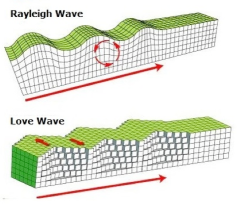61 Surface Waves
There are two types of surface waves, Rayleigh waves (R-waves) and Love (L-waves) waves.
All surface waves travel slower than body waves and Rayleigh waves are slower than Love waves. Surface waves bring the most destruction to structures.
Rayleigh waves, R-waves, are named after Lord Rayleigh (John Strutt), an English aristocrat who, in his work as a scientist and mathematician, developed a detailed mathematical accounting of the type of surface wave named after him. Rayleigh waves are set off by the combined effect of P- and S-waves on the earth’s surface. Rayleigh waves are sometimes called rolling waves. In Rayleigh waves the surface of the earth rises up and sinks down in crests and troughs, similar to waves on the surface of water. People who are outdoors during a major earthquake commonly see Rayleigh waves moving across the surface of the earth, and can feel the ground rising and falling as the waves pass beneath them.
Love waves, sometimes called L-waves, are named after Augustus Love, an English mathematician and physicist who first modeled them mathematically. Love waves involve the surface shearing sideways and then returning to its original form as each wave passes.
Diagram below shows motions of surface waves.

